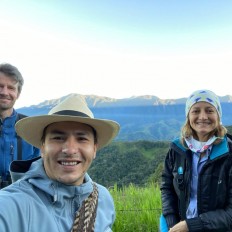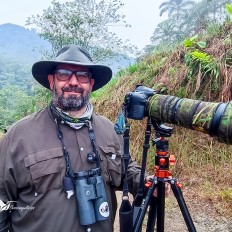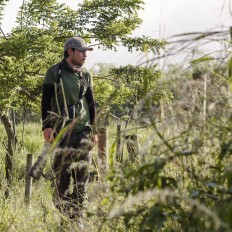Top species
- Chestnut Wood-Quail (Odontophorus hyperythrus)
- White-throated Daggerbill (Schistes albogularis)
- Rufous-gaped Hillstar (Urochroa bougueri)
- Purple-bibbed Whitetip (Urosticte benjamini)
- Empress Brilliant (Heliodoxa imperatrix)
- Semicollared Hawk (Microspizias collaris)
- Solitary Eagle (Buteogallus solitarius)
- Cloud-forest Pygmy-Owl (Glaucidium nubicola)
- Lanceolated Monklet (Micromonacha lanceolata)
- Toucan Barbet (Semnornis ramphastinus)
- Choco Toucan (Ramphastos brevis)
- Grayish Piculet (Picumnus granadensis)
- Yellow-eared Parrot (Ognorhynchus icterotis)
- Bicolored Antvireo (Dysithamnus occidentalis)
- Parker's Antbird (Cercomacroides parkeri)
- Plain-backed Antpitta (Grallaria haplonota)
- Yellow-breasted Antpitta (Grallaria flavotincta)
- Nariño Tapaculo (Scytalopus vicinior)
- Tatama Tapaculo (Scytalopus alvarezlopezi)
- Pacific Tuftedcheek (Pseudocolaptes johnsoni)
- Uniform Treehunter (Thripadectes ignobilis)
- Fulvous-dotted Treerunner (Margarornis stellatus)
- Club-winged Manakin (Machaeropterus deliciosus)
- Orange-breasted Fruiteater (Pipreola jucunda)
- Choco Vireo (Vireo masteri)
- Black Solitaire (Entomodestes coracinus)
- Yellow-collared Chlorophonia (Chlorophonia flavirostris)
- Dusky Chlorospingus (Chlorospingus semifuscus)
- Crested Ant-Tanager (Habia cristata)
- Black-and-gold Tanager (Bangsia melanochlamys)
- Purplish-mantled Tanager (Iridosornis porphyrocephalus)
- Glistening-green Tanager (Chlorochrysa phoenicotis)
- Multicolored Tanager (Chlorochrysa nitidissima)
- Rufous-throated Tanager (Ixothraupis rufigula)
- Indigo Flowerpiercer (Diglossa indigotica)
List up to ca. 25 species that:
• have a limited distribution range and/or are rare on a global level
• are most sought-after by birdwatchers at this site
• and are relatively easy to see at this site (year-round or seasonally)
| Chestnut Wood-Quail (Odontophorus hyperythrus) | |
| White-throated Daggerbill (Schistes albogularis) | |
| Rufous-gaped Hillstar (Urochroa bougueri) | |
| Purple-bibbed Whitetip (Urosticte benjamini) | |
| Empress Brilliant (Heliodoxa imperatrix) | |
| Semicollared Hawk (Microspizias collaris) | |
| Solitary Eagle (Buteogallus solitarius) | |
| Cloud-forest Pygmy-Owl (Glaucidium nubicola) | |
| Lanceolated Monklet (Micromonacha lanceolata) | |
| Toucan Barbet (Semnornis ramphastinus) | |
| Choco Toucan (Ramphastos brevis) | |
| Grayish Piculet (Picumnus granadensis) | |
| Yellow-eared Parrot (Ognorhynchus icterotis) | |
| Bicolored Antvireo (Dysithamnus occidentalis) | |
| Parker's Antbird (Cercomacroides parkeri) | |
| Plain-backed Antpitta (Grallaria haplonota) | |
| Yellow-breasted Antpitta (Grallaria flavotincta) | |
| Nariño Tapaculo (Scytalopus vicinior) | |
| Tatama Tapaculo (Scytalopus alvarezlopezi) | |
| Pacific Tuftedcheek (Pseudocolaptes johnsoni) | |
| Uniform Treehunter (Thripadectes ignobilis) | |
| Fulvous-dotted Treerunner (Margarornis stellatus) | |
| Club-winged Manakin (Machaeropterus deliciosus) | |
| Orange-breasted Fruiteater (Pipreola jucunda) | |
| Choco Vireo (Vireo masteri) | |
| Black Solitaire (Entomodestes coracinus) | |
| Yellow-collared Chlorophonia (Chlorophonia flavirostris) | |
| Dusky Chlorospingus (Chlorospingus semifuscus) | |
| Crested Ant-Tanager (Habia cristata) | |
| Black-and-gold Tanager (Bangsia melanochlamys) | |
| Purplish-mantled Tanager (Iridosornis porphyrocephalus) | |
| Glistening-green Tanager (Chlorochrysa phoenicotis) | |
| Multicolored Tanager (Chlorochrysa nitidissima) | |
| Rufous-throated Tanager (Ixothraupis rufigula) | |
| Indigo Flowerpiercer (Diglossa indigotica) |
Rufous-browed Tyrannulet (Phylloscartes superciliaris) was deleted by Mathias Ritschard (Admin) (2020-10-06 21:06:54)
Scaled Fruiteater (Ampelioides tschudii) was deleted by Mathias Ritschard (Admin) (2020-10-06 21:06:07)
Ornate Hawk-Eagle (Spizaetus ornatus) was deleted by Mathias Ritschard (Admin) (2020-10-06 21:01:58)
Indigo Flowerpiercer (Diglossa indigotica) was added by Mathias Ritschard (Admin) (2020-10-06 20:59:17)
Rufous-throated Tanager (Ixothraupis rufigula) was added by Mathias Ritschard (Admin) (2020-10-06 20:56:58)
Glistening-green Tanager (Chlorochrysa phoenicotis) was added by Mathias Ritschard (Admin) (2020-10-06 20:56:19)
Multicolored Tanager (Chlorochrysa nitidissima) was added by Mathias Ritschard (Admin) (2020-10-06 20:56:02)
Purplish-mantled Tanager (Iridosornis porphyrocephalus) was added by Mathias Ritschard (Admin) (2020-10-06 20:55:13)
Black-and-gold Tanager (Bangsia melanochlamys) was added by Mathias Ritschard (Admin) (2020-10-06 20:53:36)
Crested Ant-Tanager (Habia cristata) was added by Mathias Ritschard (Admin) (2020-10-06 20:52:53)
Dusky Chlorospingus (Chlorospingus semifuscus) was added by Mathias Ritschard (Admin) (2020-10-06 20:50:41)
Yellow-collared Chlorophonia (Chlorophonia flavirostris) was added by Mathias Ritschard (Admin) (2020-10-06 20:49:37)
Black Solitaire (Entomodestes coracinus) was added by Mathias Ritschard (Admin) (2020-10-06 20:48:49)
Choco Vireo (Vireo masteri) was added by Mathias Ritschard (Admin) (2020-10-06 20:46:52)
Rufous-browed Tyrannulet (Phylloscartes superciliaris) was added by Mathias Ritschard (Admin) (2020-10-06 20:44:31)
Scaled Fruiteater (Ampelioides tschudii) was added by Mathias Ritschard (Admin) (2020-10-06 20:42:37)
Orange-breasted Fruiteater (Pipreola jucunda) was added by Mathias Ritschard (Admin) (2020-10-06 20:42:10)
Club-winged Manakin (Machaeropterus deliciosus) was added by Mathias Ritschard (Admin) (2020-10-06 20:41:00)
Fulvous-dotted Treerunner (Margarornis stellatus) was added by Mathias Ritschard (Admin) (2020-10-06 20:40:00)
Uniform Treehunter (Thripadectes ignobilis) was added by Mathias Ritschard (Admin) (2020-10-06 20:38:49)
Pacific Tuftedcheek (Pseudocolaptes johnsoni) was added by Mathias Ritschard (Admin) (2020-10-06 20:37:37)
Nariño Tapaculo (Scytalopus vicinior) was added by Mathias Ritschard (Admin) (2020-10-06 20:36:07)
Tatama Tapaculo (Scytalopus alvarezlopezi) was added by Mathias Ritschard (Admin) (2020-10-06 20:35:27)
Yellow-breasted Antpitta (Grallaria flavotincta) was added by Mathias Ritschard (Admin) (2020-10-06 20:35:05)
Plain-backed Antpitta (Grallaria haplonota) was added by Mathias Ritschard (Admin) (2020-10-06 20:34:39)
Parker's Antbird (Cercomacroides parkeri) was added by Mathias Ritschard (Admin) (2020-10-06 20:34:06)
Bicolored Antvireo (Dysithamnus occidentalis) was added by Mathias Ritschard (Admin) (2020-10-06 20:33:08)
Yellow-eared Parrot (Ognorhynchus icterotis) was added by Mathias Ritschard (Admin) (2020-10-06 20:31:52)
Grayish Piculet (Picumnus granadensis) was added by Mathias Ritschard (Admin) (2020-10-06 20:30:50)
Choco Toucan (Ramphastos brevis) was added by Mathias Ritschard (Admin) (2020-10-06 20:30:19)
Toucan Barbet (Semnornis ramphastinus) was added by Mathias Ritschard (Admin) (2020-10-06 20:29:26)
Lanceolated Monklet (Micromonacha lanceolata) was added by Mathias Ritschard (Admin) (2020-10-06 20:29:20)
Cloud-forest Pygmy-Owl (Glaucidium nubicola) was added by Mathias Ritschard (Admin) (2020-10-06 20:28:21)
Solitary Eagle (Buteogallus solitarius) was added by Mathias Ritschard (Admin) (2020-10-06 20:27:52)
Semicollared Hawk (Microspizias collaris) was added by Mathias Ritschard (Admin) (2020-10-06 20:26:41)
Ornate Hawk-Eagle (Spizaetus ornatus) was added by Mathias Ritschard (Admin) (2020-10-06 20:26:04)
Purple-bibbed Whitetip (Urosticte benjamini) was added by Mathias Ritschard (Admin) (2020-10-06 20:24:56)
Empress Brilliant (Heliodoxa imperatrix) was added by Mathias Ritschard (Admin) (2020-10-06 20:23:07)
Rufous-gaped Hillstar (Urochroa bougueri) was added by Mathias Ritschard (Admin) (2020-10-06 20:23:00)
White-throated Daggerbill (Schistes albogularis) was added by Mathias Ritschard (Admin) (2020-10-06 20:21:45)
Chestnut Wood-Quail (Odontophorus hyperythrus) was added by Mathias Ritschard (Admin) (2020-10-06 20:19:56)




